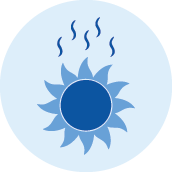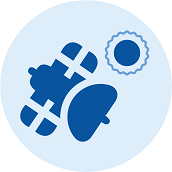Heat
Extreme heat and heatwaves can impact everyone. Even small increases above average temperatures can harm people.
Babies, older people and people with serious long-term health conditions are more at risk from heat. Find out what to do before, during and after extreme heat and heatwaves.
On this page
Reduce the impacts of heat
In hot weather, it’s best to stay inside. There are lots of ways you can get your home ready for extreme heat.
- Make sure your home is properly insulated. You can put weather stripping around doors and windows to keep cool air inside.
- If you have air conditioning, check ducts for proper insulation.
- Cover your windows. Hang shades or awnings to protect your windows from the sun.
- If you have an attic, you can install an attic fan. Fans can vent warm air out of your attic to keep your home cooler.
Get ready for heat
Make a plan with your whānau about staying safe in extreme heat. Everyone should know what to do at home, at school, at work or in the community. Some places do not have air conditioning and are not safe during extreme heat.
The best way to protect yourself from UV radiation from sunlight is to Slip, Slop, Slap and Wrap.
In New Zealand, MetService issue heat alerts for extreme heat. Stay up to date with the latest temperature forecasts and alerts from MetService.

Make a plan online with your whānau to get through an emergency. Think about the things you need every day and work out what you would do if you didn't have them.

New Zealand sunlight can have high levels of ultraviolet (UV) radiation. UV radiation can cause skin and eye damage.
You can protect yourself and your children by being SunSmart. Learn how to keep safe while still living life in the sun on the SunSmart website.
What to do during extreme heat and heatwaves
In hot weather, stay inside or in the shade. Limit physical activity and drink water.
There are things you can do to keep cool at home.
- Open your windows if there is a breeze. Keep your curtains or blinds closed.
- Have a cool shower.
- Wear loose, lightweight clothing.
- If your home is not humid, hang wet towels to cool down the air.
If you cannot keep your home cool, go to a public place that has air conditioning, such as a library or shopping mall.
Watch for signs of heat exposure:
- Heat rash
- Heat cramps
- Sunburn
- Heat exhaustion
- Heatstroke/sunstroke
Seek immediate medical attention if you see signs of heatstroke/sunstroke. St John has information on identifying and treating heat-related conditions.
Check on your neighbours and anyone who might need your help.
Stay informed during extreme heat. Listen to the radio or follow your Civil Defence Emergency Management Group online. Follow the instructions of civil defence and emergency services.
-
Pets and other animals are at risk from extreme heat. Very young and older animals, and animals with short snouts, are more at risk.
Most animals do not sweat. They rely on panting, wetting down, shade, cool earth, and drinking water to stay cool. Animals cannot explain their needs, so it is up to you to take extra care of them during extreme heat.
- Check on your animals often.
- Make sure your animals are indoors or in the shade.
- Provide plenty of water for drinking as well as for cooling. Your animals may need twice as much water as normal.
- If you see signs of heat stress, call your veterinarian.

The Ministry for Primary Industries (MPI) has advice for preparing a plan for your animals. It includes checklists for different types of animals and different emergencies. Work through the checklists to develop your plan.

Find your local Civil Defence Emergency Management (CDEM) Group.

Extreme heat can be serious and life threatening.
St John has first aid advice for identifying and treating heat-related conditions.

Extreme heat can cause illness and death. But effective planning and actions can reduce its effects on health.
Find information about the effects of high heat on health and how to treat them on the Health New Zealand Te Whatu Ora website.

Working in extreme heat can be dangerous.
Find more information about working safely in extreme temperatures on the WorkSafe website.
-
There is no universal definition of a heatwave. The Intergovernmental Panel on Climate Change defines a heatwave as a period of abnormally hot weather, often defined relative to the usual weather in a specific location, lasting for at least two days.
In New Zealand, extreme heat is monitored by MetService. MetService issue alerts on days where heat could cause impacts to health, infrastructure or animals.
Extreme temperature looks different in different parts of New Zealand. MetService heat alerts trigger depending on the region. For example, Gisborne would get a heat alert if the temperature was over 32 degrees Celsius. But Greymouth would get a heat alert if the temperature was over 27 degrees Celsius.
In New Zealand, because periods of extreme heat are rare, heat alerts are shorter than in other countries. MetService trigger a heat alert for a one-day extreme spike in heat. MetService also trigger heat alerts if there are two or more days of unusual humidity.
Types of hazards | Ngā momo matepā
In New Zealand we have a lot of natural hazards. Find out what to do before, during and after each type of emergency.










